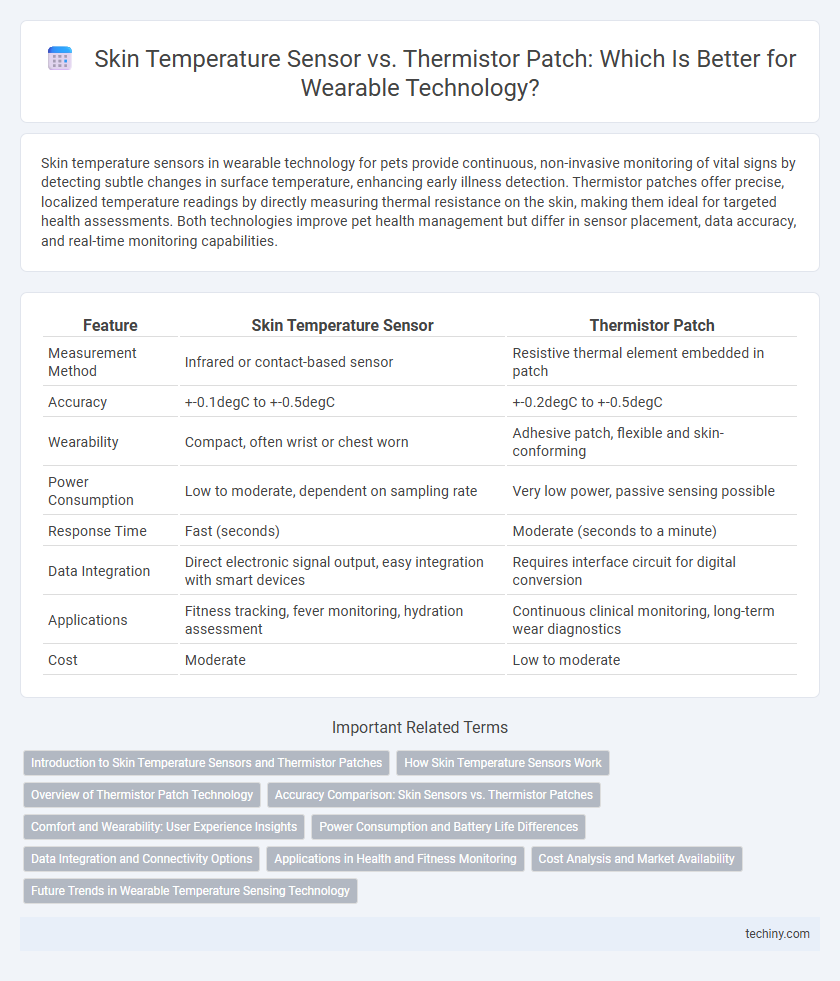Skin temperature sensors in wearable technology for pets provide continuous, non-invasive monitoring of vital signs by detecting subtle changes in surface temperature, enhancing early illness detection. Thermistor patches offer precise, localized temperature readings by directly measuring thermal resistance on the skin, making them ideal for targeted health assessments. Both technologies improve pet health management but differ in sensor placement, data accuracy, and real-time monitoring capabilities.
Table of Comparison
| Feature | Skin Temperature Sensor | Thermistor Patch |
|---|---|---|
| Measurement Method | Infrared or contact-based sensor | Resistive thermal element embedded in patch |
| Accuracy | +-0.1degC to +-0.5degC | +-0.2degC to +-0.5degC |
| Wearability | Compact, often wrist or chest worn | Adhesive patch, flexible and skin-conforming |
| Power Consumption | Low to moderate, dependent on sampling rate | Very low power, passive sensing possible |
| Response Time | Fast (seconds) | Moderate (seconds to a minute) |
| Data Integration | Direct electronic signal output, easy integration with smart devices | Requires interface circuit for digital conversion |
| Applications | Fitness tracking, fever monitoring, hydration assessment | Continuous clinical monitoring, long-term wear diagnostics |
| Cost | Moderate | Low to moderate |
Introduction to Skin Temperature Sensors and Thermistor Patches
Skin temperature sensors and thermistor patches are pivotal in wearable technology for continuous health monitoring, offering precise measurement of dermal temperature variations. Thermistor patches utilize temperature-sensitive resistors that change resistance with temperature fluctuation, providing accurate and localized readings essential for detecting fever or thermal stress. These sensors are integrated into wearable devices to enable real-time data collection, enhancing personalized medical diagnostics and fitness tracking through non-invasive means.
How Skin Temperature Sensors Work
Skin temperature sensors utilize infrared thermography or thermocouples to detect the heat emitted from the skin surface, converting thermal energy into electrical signals for precise temperature measurement. Thermistor patches, embedded with temperature-sensitive resistors, respond to skin temperature changes by altering their resistance, allowing continuous and localized monitoring. Both technologies provide critical data for health and fitness applications by accurately tracking body temperature variations in real-time.
Overview of Thermistor Patch Technology
Thermistor patches in wearable technology utilize temperature-sensitive resistors that exhibit a predictable change in resistance with temperature fluctuations, enabling accurate skin temperature monitoring. These patches are designed for direct skin contact, offering continuous, real-time data collection with high sensitivity and rapid response times compared to traditional sensor types. Integration with wireless modules allows seamless transmission of thermal data for applications in health monitoring, fitness tracking, and personalized medical diagnostics.
Accuracy Comparison: Skin Sensors vs. Thermistor Patches
Skin temperature sensors used in wearable technology offer real-time monitoring but can be influenced by environmental factors such as ambient temperature and sweat, potentially reducing accuracy. Thermistor patches, embedded directly on the skin, provide more stable and precise temperature readings due to their consistent contact and minimal external interference. Studies indicate thermistor patches achieve +-0.1degC accuracy, outperforming typical skin sensors that often vary by +-0.3degC under similar conditions.
Comfort and Wearability: User Experience Insights
Skin temperature sensors integrated into wearable devices offer enhanced comfort and wearability due to their thin, flexible design that minimizes skin irritation and allows for prolonged use without discomfort. Thermistor patches, while accurate in temperature measurement, can be bulkier and less breathable, often causing user discomfort during extended wear. User experience studies indicate a strong preference for skin temperature sensors in continuous health monitoring because they deliver reliable data alongside superior comfort.
Power Consumption and Battery Life Differences
Skin temperature sensors in wearable technology typically consume less power compared to thermistor patches due to their integrated low-energy components and advanced signal processing. Thermistor patches, while highly accurate, often require continuous active heating and analog signal conditioning, leading to higher power consumption. This results in longer battery life for devices using skin temperature sensors, making them more suitable for extended wearable applications.
Data Integration and Connectivity Options
Skin temperature sensors in wearable technology typically offer direct data integration with smartphone apps and cloud platforms via Bluetooth Low Energy, enabling real-time monitoring and seamless connectivity. Thermistor patches require additional circuitry for signal conditioning and often depend on specialized hubs or external devices to facilitate data transmission, which can complicate integration with common health ecosystems. Advances in sensor fusion techniques and IoT protocols are enhancing the interoperability of both sensor types, promoting more comprehensive health data aggregation and analysis.
Applications in Health and Fitness Monitoring
Skin temperature sensors integrated into wearable devices provide continuous and non-invasive monitoring of body temperature, crucial for early detection of fever, stress, and metabolic changes during exercise. Thermistor patches, known for their high sensitivity and accuracy, are commonly used in clinical and fitness settings to track localized temperature variations, aiding in muscle fatigue assessment and wound healing monitoring. Both technologies enhance personalized health and fitness tracking by delivering real-time data that supports optimized workout plans and early identification of health issues.
Cost Analysis and Market Availability
Skin temperature sensors in wearable technology generally present higher upfront costs compared to thermistor patches due to advanced materials and integrated digital capabilities. Thermistor patches are widely available and cost-effective, making them ideal for mass-market applications with basic temperature monitoring needs. The market shows increasing demand for skin temperature sensors in premium health devices, whereas thermistor patches dominate the budget-conscious segment with scalable production advantages.
Future Trends in Wearable Temperature Sensing Technology
Future trends in wearable temperature sensing technology emphasize the integration of advanced skin temperature sensors with enhanced accuracy and real-time monitoring capabilities, surpassing traditional thermistor patches. Emerging materials such as flexible electronics and nanomaterials enable more comfortable, skin-conformal devices that provide continuous temperature data with minimal interference. Innovations in wireless connectivity and AI-driven analytics further advance personalized health monitoring and early detection of physiological changes.
skin temperature sensor vs thermistor patch Infographic

 techiny.com
techiny.com